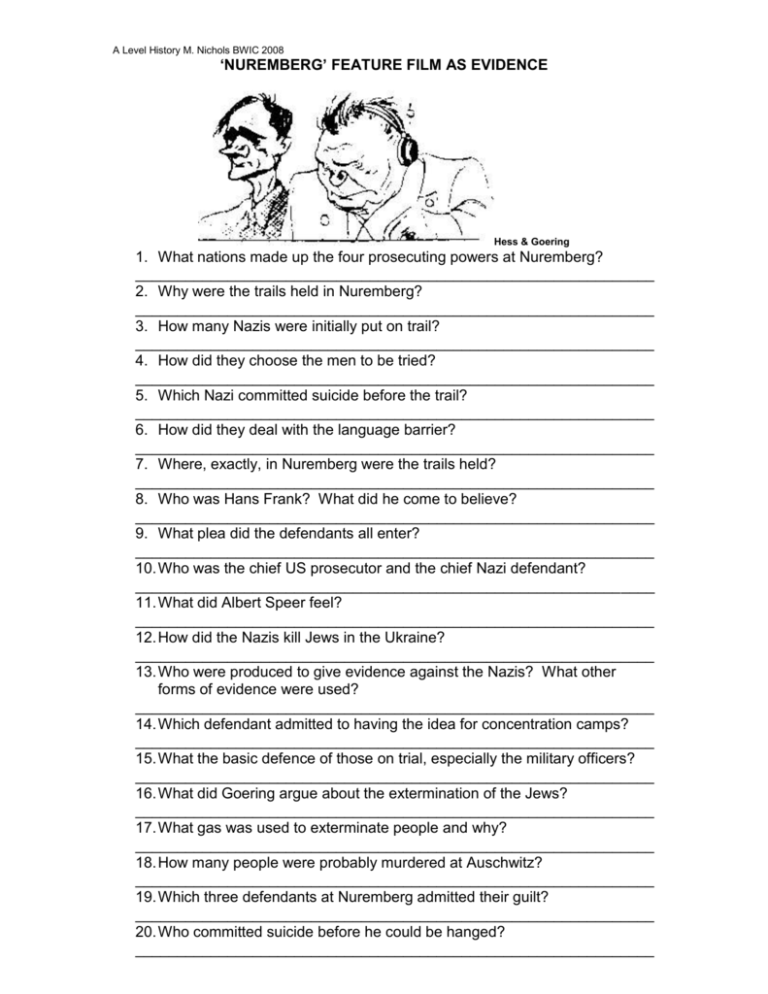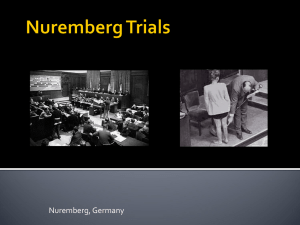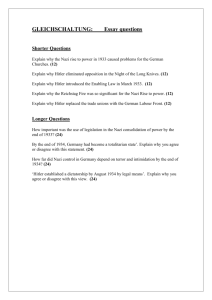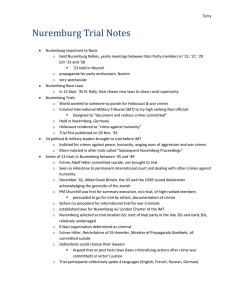'the nuremberg trails' feature film
advertisement

A Level History M. Nichols BWIC 2008 ‘NUREMBERG’ FEATURE FILM AS EVIDENCE Hess & Goering 1. What nations made up the four prosecuting powers at Nuremberg? ______________________________________________________________ 2. Why were the trails held in Nuremberg? ______________________________________________________________ 3. How many Nazis were initially put on trail? ______________________________________________________________ 4. How did they choose the men to be tried? ______________________________________________________________ 5. Which Nazi committed suicide before the trail? ______________________________________________________________ 6. How did they deal with the language barrier? ______________________________________________________________ 7. Where, exactly, in Nuremberg were the trails held? ______________________________________________________________ 8. Who was Hans Frank? What did he come to believe? ______________________________________________________________ 9. What plea did the defendants all enter? ______________________________________________________________ 10. Who was the chief US prosecutor and the chief Nazi defendant? ______________________________________________________________ 11. What did Albert Speer feel? ______________________________________________________________ 12. How did the Nazis kill Jews in the Ukraine? ______________________________________________________________ 13. Who were produced to give evidence against the Nazis? What other forms of evidence were used? ______________________________________________________________ 14. Which defendant admitted to having the idea for concentration camps? ______________________________________________________________ 15. What the basic defence of those on trial, especially the military officers? ______________________________________________________________ 16. What did Goering argue about the extermination of the Jews? ______________________________________________________________ 17. What gas was used to exterminate people and why? ______________________________________________________________ 18. How many people were probably murdered at Auschwitz? ______________________________________________________________ 19. Which three defendants at Nuremberg admitted their guilt? ______________________________________________________________ 20. Who committed suicide before he could be hanged? ______________________________________________________________ A Level History M. Nichols BWIC 2008 Fill in the table on what happened to the defendants. Some have been done for you. DEFENDANT IMAGE IN THE END Doenitz, Karl German admiral who would eventually command entire navy. Chosen by Hitler to succeed him as fuhrer. Negotiated surrender following Hitler's suicide. Frank, Hans Governor-general of Nazioccupied Poland, called the "Jew butcher of Cracow." Frick, Wilhelm Minister of the Interior Frick was one of eleven defendants sentenced to death. He said, "Hanging--I didn't expect anything different....Well, I hope they get it over with fast." (10/1/46) Frick was hanged on Oct. 16, 1946. Fritzsche, Hans Head of the Radio Division, one of twelve departments in Goebbel's Propoganda Ministry Funk, Walther Minister of Economics Goering, Hermann Reichsmarschall and Luftwaffe (Air Force) Chief; President of Reichstag; Director of "Four Year Plan" Goering committed suicide on the day before his scheduled hanging by taking a cyanide pill that was smuggled into his cell. Goering wrote in his suicide note, "I would have no objection to getting shot," but he thought hanging was inappropriate for a man of his position. A Level History M. Nichols BWIC 2008 Hess, Rudolf Deputy to the Fuhrer and Nazi Party Leader. Flew to GB in 1940 to arrange a peace. Jodl, Alfred Chief of Operations for the German High Command Kaltenbrunner, Ernst Chief of RSHA (an organization which includes offices of the Gestapo, the SD, and the Criminal Police) and Chief of Security Police Keitel, Wilhelm Chief of Staff of the German High Command Neurath, Konstantin von Minister of Foreign Affairs (until 1938), then Reich Protector for Bohemia and Moravia Neurath was sentenced to fifteen years in prison. He was released because of poor health in 1954, and died two years later. Papen, Franz von Reich Chancellor prior to Hitler, Vice Chancellor under Hitler, Ambassador to Turkey Raeder, Erich Commander in Chief of the German Navy Ribbentrop, Joachim von Foreign Minister Raeder was sentenced to life in prison. He served nine years before his release in 1955. He died in 1960 at age 84. A Level History M. Nichols BWIC 2008 Rosenberg, Alfred Chief Nazi Philosopher and Reichminister for the Eastern Occupied Territories Rosenberg was hanged on October 16, 1946. Sauckel, Fritz Chief of Slave Labor Recruitment Schacht, Hjalmar Reichsbank President and Minister of Economics before the War Schirach, Baldur von Hitler Youth Leader Seyss-Inquart, Arthur Austrian Chancellor, then Reich Commissioner for the Netherlands. Responsible for inviting the Anschluss. Speer, Albert Reichminister of Armaments and Munitions. Thought of assassinating Hitler. Streicher, Julius Anti-Semitic Editor of Der Sturmer Seyss-Inquart was hanged on October 16, 1946.









